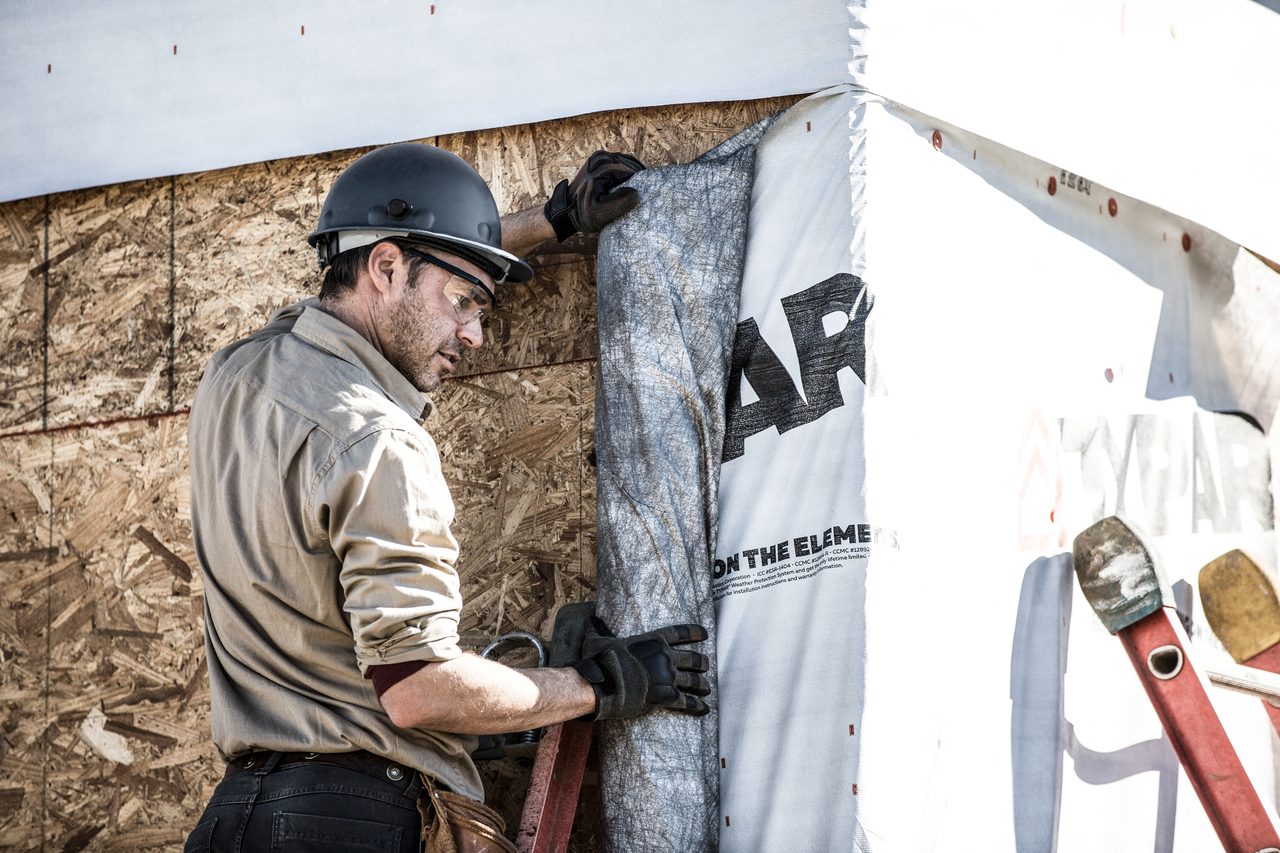Designing for moisture management and air holdout within a wall system can be a complicated business. Climate, region, code requirements, and advancing building product technologies all influence the specification process. Consider, too, that while the industry races to design tightly sealed wall systems that walls must also be able to “breathe.” The type of cladding material chosen for a project not only affects the building’s overall aesthetic, it also plays a central role in how the rest of wall system should be designed to best protect the structure from the elements.
There are several cladding options on the market today, from stucco to fiber cement boards, and none of them are completely impervious to the effects of water penetration. A well-designed wall system will account for this by incorporating strategies for managing bulk water and water vapor, such as a weather resistant barrier (WRB). Knowing how a building’s cladding system will interact with the WRB (sometimes referred to as housewrap) will help you design a wall system that works in harmony to protect against mold, rot, and other moisture-related issues.
Cladding Considerations
In many areas around the country, building codes are driving the need for better moisture management solutions. The International Residential Code (IRC) requires the use of water-resistive barriers, but some states have added even more prescriptive measures to their codes that now include the use of drainage planes, and others are expected to follow.
In response to widespread failures of stucco cladding installed over wood-based sheathing, both the IRC and International Building Code (IBC) updated their requirements to include “a minimum 3/16-inch space…between the stucco and water-resistive barrier or a space having a drainage efficiency of not less than 90 percent…be added to the exterior side of the water-resistive barrier.” The ASTM E2273 standard—“Standard Test Method for Determining the Drainage Efficiency of Exterior Insulation and Finish Systems (EIFS) Clad Wall Assemblies”—was itself developed in response to thousands of EIFS buildings with failures due to the lack of drainage between adhered expanded polystyrene (EPS) rigid insulation and sheathings, both oriented strand board (OSB) and gypsum board.
At the same time, growing preference for absorptive cladding materials like fiber cement has made moisture management more important than ever, with some manufacturers even going so far as to require drainage gaps behind their materials.
Depending on the type of material and how it is installed, it may be beneficial—if not required—to consider a building wrap with integrated drainage. With vinyl siding, a standard smooth building wrap will likely perform well because the vinyl siding has built in drainage holes and fits loosely on the wall. Fiber cement board, however, is a different story.
Fiber cement is gaining popularity because it is strong, easy to install, less expensive than wood cladding, and is very low maintenance. The material is both fire and insect-resistive and can even increase the building’s energy efficiency as part of a tight building envelope. However, because fiber cement board is a tightly fastened cladding, it might allow water to become trapped between the siding and a standard smooth building wrap, where it could pool before eventually making its way through the wrap and into the framing. These are cases where a drainable building wrap would provide the needed capillary break to allow water to drain out of the assembly. In fact, many manufacturers require the use of a drainable wrap to qualify for the warranty.
Reservoir Cladding and Vapor Drive
Reservoir claddings such as brick, stucco and stone present another set of issues. This is because moisture absorbed by these materials can be driven inward by solar radiation. The heating of the stored water raises its vapor pressure, driving it both inward and outward. This inward vapor drive is even higher when the indoor environment is cooled by air conditioning. Proper drainage strategies ensure the inwardly driven moisture doesn’t infiltrate the wall cavity, where it can create mold issues and other potential health threats.
Typically, this inwardly driven moisture vapor is managed by separating the cladding from the rest of the assembly with a capillary break, which can be an air gap or a sheathing material that sheds or does not absorb/pass water. Impermeable sheathing, such as extruded polystyrene, is one option for halting inward vapor drive. In these types of assemblies, the inwardly driven moisture condenses on the surface of the XPS sheathing and drains downward.
In situations where a reservoir cladding is paired with a highly permeable sheathing like gypsum board (which can be as high as 50 perms) or a moisture-retentive material like oriented strand board, an air gap may not be enough to slow down inward moisture intrusion. In these applications, a WRB is needed to reduce unwanted moisture intrusion.
However, the permeability of the WRB layer must be carefully considered, as well. In a recent article on the topic, “Drain the Rain...On the Plane...the Drainage Plane[1],” building scientist Joseph Lstiburek argues there are two reasonable ways to deal with inward vapor drive—a “vapor throttle” or an air gap. With a very small air gap (less than 3/16 inches), he writes, there is a “sweet spot” for vapor transmission control of the water control layer. That “sweet spot” is somewhere between 10 and 20 perms. If it is any more permeable the moisture driven out of the back side of the reservoir cladding into the air space will blow through the layer, through the permeable sheathing and into the wall cavity. Any lower and the outward drying potential of the cavity is compromised.
All photos courtesy of TYPAR Construction Products.
"When choosing a building wrap, be sure to pay attention to its surfactant resistance capabilities..."

